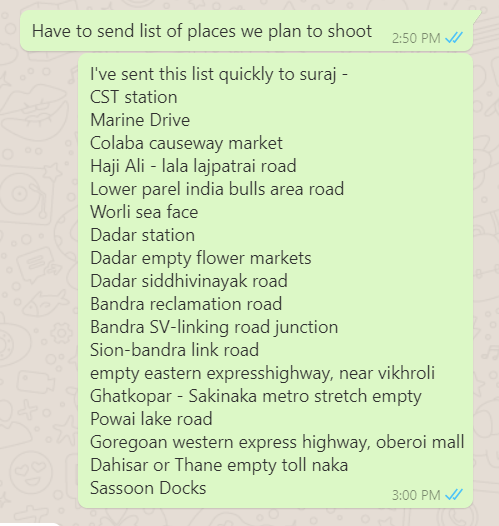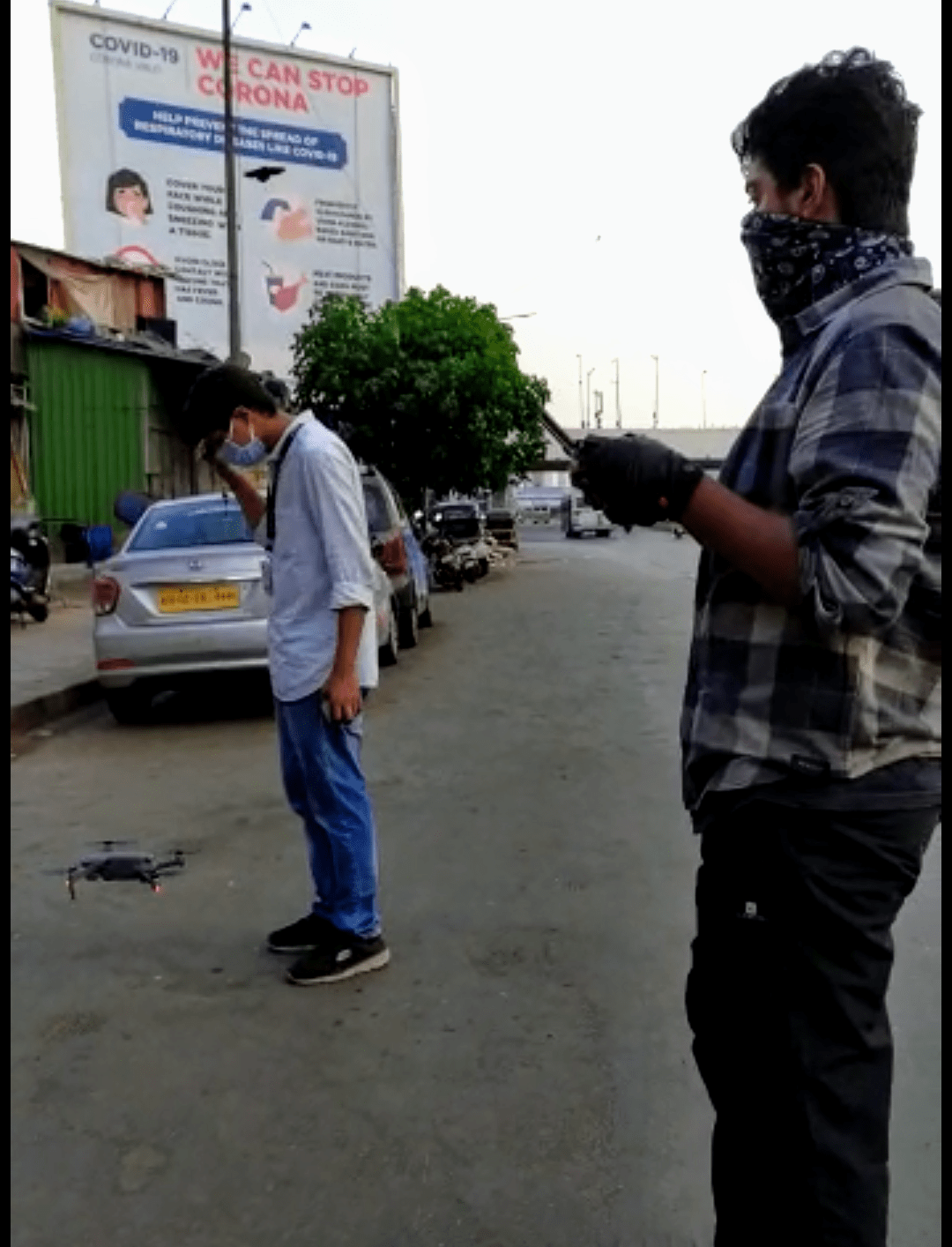
“Dabbo nai bhulto”(Don’t forget your lunch), shouted my mom as I was calling for the lift. She’d prepared theplas for me and my team. I rushed back at the house door to collect the lunch and noticed her worried eyes as I waited for the lift to come back. “Dhyan rakhje” (Take care) she said and slowly shut the door as my lift arrived.
The lift was filled with printouts about safety tips on COVID-19. As it went from the 9th floor to ground, I saw myself in the mirror like I had never seen before. With a pair of gloves and mask on, I could relate to my mom’s worry in that moment and realized the gravity of the situation. I was stepping out of my house after 15 days. A part of me felt fresh but the other part felt equally worried.
It was pitch dark as I left on my scooter at 5:00 AM from Thane. The roads were dead quiet but then I thought it’s early morning anyway. The only sound passing through my ears was that of the wind. It almost felt like a race with no one to compete with. I’ve never experienced riding a scooter like that in Mumbai.
After passing through two different police check-points, I reached Chembur in 35 mins to join my co-director, Omkar Phatak, in his car. We’ve been friends for 10 years, and this was the first time I met him where we didn’t do the casual bros hug. Just a simple, “hey, all good?” And we left in his car. He too was wearing a mask.
As the usual Covid-19 conversations ended, we discussed how unreal it felt to pass through the popular empty highways and flyovers. We picked up our other two partners for the day - Vinit Pednekar and Suraj Sawant and reached our first shoot spot bang on sunrise time as planned.
At 7:00 AM, standing right opposite the Chhatrapati Shivaji Maharaj Terminus (CSMT), the heart of Mumbai’s identity and it’s rail network, we were joined by two police officers to keep a check as we finally took our first shot that you see right at the beginning of the film. All four of us gasped at the beauty of this heritage structure as Omkar slowly pulled back, taking the drone higher in the air, and showing us the now empty roads and railway tracks. Like me, many in Mumbai have visited the CST area throughout their lives, but never once anyone would have seen it without a single soul in sight, without it’s chaotic cacophony.

Right after we finished capturing the areas of CST and exhausted our 1st two batteries, I realized what’s going to happen with us throughout the day. An emotional dilemma, one where we awed at the beauty of the city as filmmakers and on another side where we felt truly sad to see it without its people as Mumbaikars. The two feelings are inseparable and it’s bittersweet to feel happy and sad at the same time. Something we all feel in great films, happily sad. Omkar and I discussed this and he too felt the exact same. We decided to express this emotion in the final edit of the film as well and hopefully we succeeded.

Our initial list of places to shoot was extensive for covering all three parts of the city - south, central and western parts. But we got to know from the authorities that these many places cannot be allowed and aren't safe to do as well. Even logistically and economically, it wasn’t possible to cover so much in a single day of shoot time. We were told to pick 4 areas only and then it became a hard choice albeit an obvious one to choose the ones we did - CST, Marine Lines, Dadar and Bandra. Going from south to west, we picked the busiest places to convey the lock-down effectively as well as these are locations recognized globally.
Another challenge we faced like many drone fliers do, was battery life. Even though we had the amazing DJI Mavic 2 Pro Hasselblad with its reliable 20 min flight time, it’s still not enough as one has to keep in mind the time it takes for the drone to reach the desired elevation and a cinematic composition to go with. But still we would discuss our shots as much as possible prior to flight time and optimize the shoot time. To further compensate, we had managed to carry 5 batteries and were able to utilize those for CST and Marine Lines.
I video called my mom on WhatsApp out of sheer bliss, after all, we feel happier when we share. Through the small screen on her phone, she smiled and repeatedly said it’s so pretty as I showed her the entire ‘C’ shaped marine drive stretch, completely empty and a pitch blue sky shimmering its light on the Arabian sea waters. I told her how fresh the air felt and how peaceful it was to hear just the waves hitting the rocks. The juxtaposition of seeing the natural sea against our empty streets and tall skyscrapers, felt truly like what Mumbai offers as a maximum city. A seafront for city-goers to visit, sit and relax from the hustle-bustle of their busy days.
But again, seeing no soul in sight at that stretch, felt painful. The sense of urgency to keep our water and beaches clean felt so important in that moment. Preservation is key if we want our city to continue offering this experience and I hope Mumbaikars realize this sooner.
At Marine Lines, as our drone flew 2 km away from the land, for the first time in my life I could see how our city is an island as both the water bodies on each side of the city could be clearly seen - the marine bay waters on one side and Mumbai port trust waters on the other far north end. This wealth of visual knowledge about our city isn’t something I had ever seen.

Since the lockdown began, the air quality has improved drastically. This contributed to capturing buildings that were 2-3 KM far from where we were shooting. With no smog in the air, every place felt fresher to breathe in. Hopefully, post the lock-down, our authorities and citizens realize how important it is to have cleaner air for people’s health as well as for the city to have a sustainable development model that co-exists with nature.
We had to take a break after covering Marine lines as all our 5 batteries had died. We took a lunch break at our Dadar office and charged all the batteries. With my mom’s delicious theplas, poha and a packet of maggi, four of us finished our lunches and waited patiently for the batteries to charge up. By 4:00 PM, we left to cover Dadar and Bandra. It became a race against time, as the sun kept moving towards the horizon.
For the last 2 years, I’ve travelled to Dadar by the local train and every Mumbaikar knows that it’s the busiest station of all. Seeing it dead empty felt unsettling, rather haunting. No series of distinctive sounds I’m used to hearing - the trains, announcements, vendors, a swarm of people walking, everything reduced to a sea of nothingness. The only sound echoing throughout the station was at the kabutar khana, of pigeons flying around which gave a sense of relief. The BMC officials were present there, feeding the pigeons in the absence of people. It was like nature reclaiming its place!
Post Dadar, we raced to Bandra as the sun was ready to begin its the magical golden hour. What we didn’t know was that beyond Bandra’s S.V. road junction, the area is marked as a ‘No Fly Zone’. So we couldn’t go beyond the junction and quickly decided to chase the other areas - Reclamation and Bandra-Worli Sea Link which were out of the no-fly zone.
Before I continue, I should confess - it's a wet dream of every filmmaker in Mumbai to get a chance at filming the majestic Sea Link. And I’m grateful that I got one. We danced in joy as the sun went down in front of the Sea Link and it looked truly spectacular as evident in the film.

For a drone flier, it’s a huge risk to fly in areas where there could be potential cables or hurdles to crash in. Going above the Sea Link was one such risk for us as we couldn’t clearly see where the cables were. But alas! We got what we wanted safely and the results are breathtaking. In moments like these, I’m at the mercy of the incredible flying skills of Omkar.
Unfortunately, by the time the sunset, four of our batteries had died and the last one only had 30 per cent left. This meant that literally it wouldn’t fly more than 5 minutes and so we flew it then and there. By 8 PM with no charging place available around us in Bandra and our families calling us to return home on time, we decided to end the shoot. That’s why the film doesn’t have much night coverage. But I hope we’ve compensated for it with some great daytime shots.
 Kushang Dholakia (Left) and Omkar Phatak (Right)Later as I waved goodbye to Omkar and left in my scooter for Thane, I started thinking about the whole experience of the day and it truly felt special in so many different ways. Here I was feeling like I had a beautiful shoot day in the middle of a global pandemic and that notion of mixed feelings is what I’ve tried expressing in the film. To give the people a sense of relief from the lock-down for just 5 minutes. Because we all need it in these testing times.
Kushang Dholakia (Left) and Omkar Phatak (Right)Later as I waved goodbye to Omkar and left in my scooter for Thane, I started thinking about the whole experience of the day and it truly felt special in so many different ways. Here I was feeling like I had a beautiful shoot day in the middle of a global pandemic and that notion of mixed feelings is what I’ve tried expressing in the film. To give the people a sense of relief from the lock-down for just 5 minutes. Because we all need it in these testing times.
It was 10 PM on my clock as I entered the house, my parents standing in the living room with a big relief on their faces to see me come back safe. But again none of us could give each other a hug. So I went in for a bath without touching anyone or anything. And then began the editing process. Over the next 3 days, I tried to carve out a good film from my 15-inch laptop with constant feedback from Omkar and other team members.
That’s how the film happened, without a notion of realizing we’re shooting some historic moments of Mumbai. I am thankful for the amount of appreciation and love the film has received.





